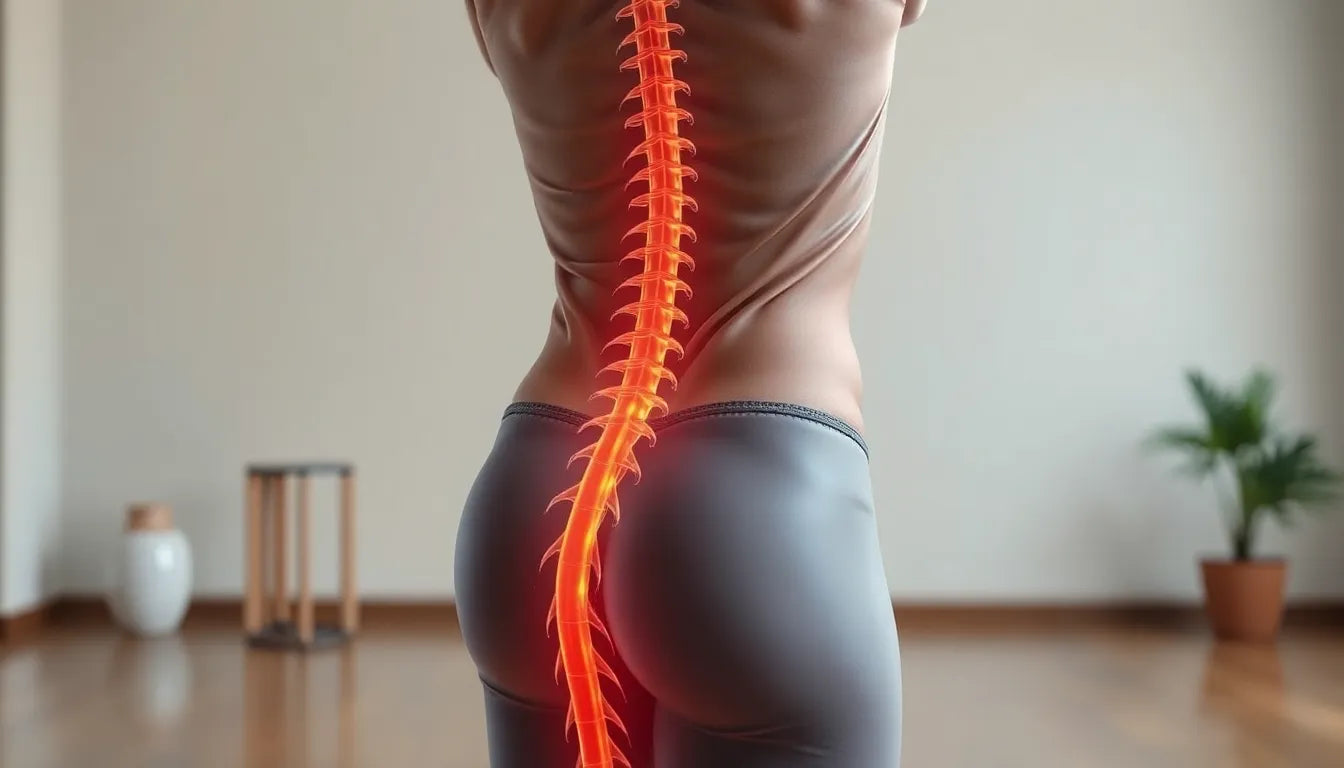Experiencing a pinched nerve in the back can be a debilitating condition that affects daily life. A pinched nerve occurs when surrounding tissues, such as bones, cartilage, muscles, or tendons, apply excessive pressure to a nerve. This pressure results in disrupted nerve function, leading to pain, tingling, numbness, or muscle weakness. In the back, common causes of a pinched nerve include lumbar radiculopathy, herniated discs, and spinal stenosis. These conditions can compress the spinal nerves, causing significant discomfort.
Understanding pinched nerves in the back
A pinched nerve in the back is often the result of structural changes in the spine. Lumbar radiculopathy, for instance, occurs when a nerve root in the lower back is compressed, leading to symptoms that may radiate down the leg. Herniated discs, where the soft center of a spinal disc pushes through a crack in the tougher exterior, can also lead to nerve compression. Spinal stenosis, a narrowing of the spaces within the spine, puts pressure on the nerves and is another frequent culprit. Symptoms of a pinched nerve can range from sharp pain and tingling to numbness and muscle weakness, significantly impacting mobility and comfort.
Addressing a pinched nerve promptly is crucial to prevent further complications. Ignoring the symptoms can lead to chronic pain and potentially permanent nerve damage. Therefore, understanding the condition and taking proactive steps to manage it can greatly improve one’s quality of life.
The role of exercise in managing pinched nerve pain
Exercise plays a pivotal role in alleviating the pain associated with a pinched nerve in the back. Targeted exercises can help reduce pressure on the nerves, improve mobility, and strengthen the muscles supporting the spine. By incorporating specific movements into your routine, you can enhance your long-term nerve health and reduce the risk of future occurrences.

Lumbar support belt
Stabilises and relieves lower back pain, ideal for sciatica and herniated discs. Adjustable for daily comfort and support.
Combining exercises aimed at immediate pain relief with those designed for long-term rehabilitation offers a comprehensive approach to managing pinched nerve pain. Immediate relief exercises focus on reducing inflammation and alleviating pressure on the affected nerve, while rehabilitation exercises aim to strengthen the core and improve spinal alignment. This holistic approach not only addresses current symptoms but also helps prevent future nerve compression.
In the subsequent sections, we will explore specific exercises that can effectively relieve back pain caused by a pinched nerve. These exercises are designed to be safe and effective, providing both immediate relief and long-term benefits. By integrating these movements into your routine, you can work towards a pain-free and more active lifestyle.
In-depth information and exercises for pinched nerve relief
To effectively manage and alleviate the discomfort caused by a pinched nerve in the back, it's essential to incorporate specific exercises into your daily routine. These exercises are designed to not only provide immediate relief but also contribute to long-term rehabilitation and prevention of future occurrences. Below, we delve into a selection of exercises that target core stability, lumbar extension, and nerve mobility, each playing a crucial role in relieving back pain associated with a pinched nerve.
Abdominal bracing for core stability
Abdominal bracing is a fundamental exercise that enhances core stability, which is vital for supporting the spine and reducing pressure on the nerves. A strong core acts as a natural brace for your spine, helping to alleviate the stress that contributes to nerve compression.
Instructions:
- Lie on your back with your knees bent and feet flat on the floor.
- Tighten your abdominal muscles as if preparing for a punch.
- Hold the contraction for 5-10 seconds while breathing normally.
- Repeat this exercise 10 times.
Prone press up for lumbar extension
The prone press up is an effective exercise for promoting lumbar extension, which helps reduce nerve compression by encouraging proper alignment of the spine. This movement is particularly beneficial for alleviating pressure on the lower back.
Instructions:
- Lie face down with your hands positioned under your shoulders.
- Slowly press your torso upward while keeping your hips on the floor.
- Hold the position for a few seconds before lowering back down.
- Perform 10 repetitions of this exercise.
Hip flexor stretch to relieve lower back pressure
Stretching the hip flexors can significantly relieve pressure on the lower back, which is often a contributing factor to pinched nerve pain. By increasing flexibility in this area, you can enhance your overall spinal health.
Instructions:
- Step one foot forward into a lunge position.
- Gently push your hips forward until you feel a stretch in the hip flexor.
- Hold the stretch for 20-30 seconds, then switch sides.
- Repeat this stretch 3 times on each side.
Figure four stretch for sciatic nerve tension
The figure four stretch targets the piriformis and gluteal muscles, which are often involved in sciatic nerve tension. This stretch helps to alleviate discomfort and improve flexibility in the lower back and hips.
Instructions:
- Lie on your back and cross one ankle over the opposite knee.
- Pull the uncrossed leg toward your chest.
- Hold the stretch for 20-30 seconds, then switch legs.
- Repeat this stretch 3 times on each side.
Lower body nerve glide for enhanced nerve mobility
Lower body nerve glides are dynamic movements designed to enhance nerve mobility, promoting better nerve function and reducing symptoms associated with a pinched nerve.
Instructions:
- Lie on your back with one leg straight and the other bent.
- Slowly extend and flex the straight leg, keeping the foot flexed.
- Perform 10 repetitions on each leg.
Bent knee stretch for lumbar relief
The bent knee stretch provides gentle lumbar relief by stretching the lower back muscles, which can help reduce nerve compression and alleviate pain.
Instructions:
- Lie on your back and bring one knee toward your chest.
- Hold the stretch for 20-30 seconds, then switch legs.
- Repeat this stretch 3 times on each side.
Incorporating these exercises into your daily routine can significantly improve your condition and provide lasting relief from the discomfort of a pinched nerve in the back. Always remember to perform these exercises gently and consult with a healthcare professional if you experience any discomfort or if you're unsure about the proper technique. By focusing on strengthening your core, improving flexibility, and promoting nerve mobility, you can enhance your spinal health and prevent future issues.
additional exercises for managing pinched nerve pain
In addition to the core exercises previously discussed, incorporating a variety of movements can further enhance flexibility, reduce tension, and support overall spinal health. These additional exercises are designed to address different aspects of mobility and muscle tension, providing comprehensive relief for a pinched nerve in the back.
side bends for lateral flexibility
Side bends are effective for improving lateral flexion and reducing muscle tension along the sides of the body. This exercise helps maintain a balanced spine and can alleviate discomfort associated with a pinched nerve.
Instructions:
- Stand with your feet shoulder-width apart.
- Slowly lean to one side, keeping the opposite arm overhead.
- Hold the position for a few seconds, then return to the starting position.
- Repeat 10 times on each side.
shoulder shrugs and rolls for cervical support
Shoulder shrugs and rolls are simple yet effective exercises that support the cervical region and alleviate tension in the shoulders and neck, which can indirectly affect the back.
Instructions:
- Stand or sit with your back straight.
- Raise your shoulders toward your ears, then roll them back down.
- Perform 10 repetitions.
scapular retraction for thoracic stability
Scapular retraction exercises enhance thoracic stability and improve posture, which is crucial for reducing the strain on the back and supporting overall spinal health.
Instructions:
- Stand or sit with your back straight.
- Squeeze your shoulder blades together, hold for a few seconds.
- Repeat 10 times.
By integrating these exercises into your routine, you can address various aspects of back health, from improving flexibility to strengthening supporting muscles. These movements not only provide relief from current discomfort but also contribute to the prevention of future nerve compression.
frequently asked questions
what are the signs that a pinched nerve requires medical attention?
Signs that a pinched nerve requires medical attention include persistent pain, loss of sensation, or muscle weakness that doesn’t improve with rest or exercises.
can exercises make a pinched nerve worse?
If performed incorrectly or too aggressively, exercises can exacerbate symptoms. It is important to start gently and consult a professional if unsure about the correct technique.
how often should these exercises be performed?
These exercises can generally be done daily, but the frequency may vary based on individual needs and recovery progress. Consulting with a healthcare professional can provide personalized guidance.
are there any exercises to avoid with a pinched nerve?
Exercises that involve high-impact activities and twisting movements should be avoided as they could strain the back further and worsen symptoms.
can these exercises help prevent future pinched nerves?
Yes, by strengthening supporting muscles and enhancing flexibility, these exercises can reduce the risk of future nerve compression, promoting long-term spinal health.
By following these guidelines and incorporating recommended exercises into your routine, you can effectively manage and prevent pinched nerve pain in the back. Always prioritize proper technique and consult with a healthcare professional for tailored advice.

Men's Posture Shirt™ - Black
Patented shirt that activates muscles, supports posture, and relieves pain—CE registered as a medical device.
Källor
- Hinge Health. ”Exercises for Pinched Nerve in Lower Back.”
- Dr. Yashar. ”Best Exercises for Pinched Nerve.”
- Integra Rehabilitation. ”Stretches for Pinched Nerve.”
- Harvard Health Publishing. ”Got a Pinched Nerve? Strategies and Treatments for Pain Relief.”
- Medical News Today. ”Pinched Nerve in Lower Back.”
- YouTube. ”Exercises for Pinched Nerve in Back.”
- NHS. ”Exercises for Sciatica.”
- CSI Orthopedics. ”6 Exercises to Relax Your Pinched Nerve.”


















